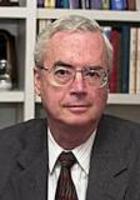Paul Fleury
Frederick William Beinecke Professor of Engineering and Applied Physics and Professor of Physics
 Paul Fleury, B.S. and M.S. John Carroll University, Ph.D. MIT, Yale faculty member since 2000: You have brought to Yale a lifetime of experience in basic and applied science and engineering, and leadership in research administration. Trained by the legendary physicist Charles Townes, you were among the first physicists to use the newly invented laser to do fundamental science. When you arrived at Bell Laboratories in 1965 you applied your expertise in light scattering from solids to uncover their inner workings in a series of groundbreaking experiments. The quantum vibrational and magnetic properties of solids were revealed in their fine details, thanks to your careful studies. You detected and studied the subtle clues that signal the onset of a change of the phases of matter. Your seminal contributions were recognized with the 1992 Frank Isakson Prize of the American Physical Society, awarded for advancing the understanding of optical effects in solids, and your election to the National Academy of Sciences in 1999.
Paul Fleury, B.S. and M.S. John Carroll University, Ph.D. MIT, Yale faculty member since 2000: You have brought to Yale a lifetime of experience in basic and applied science and engineering, and leadership in research administration. Trained by the legendary physicist Charles Townes, you were among the first physicists to use the newly invented laser to do fundamental science. When you arrived at Bell Laboratories in 1965 you applied your expertise in light scattering from solids to uncover their inner workings in a series of groundbreaking experiments. The quantum vibrational and magnetic properties of solids were revealed in their fine details, thanks to your careful studies. You detected and studied the subtle clues that signal the onset of a change of the phases of matter. Your seminal contributions were recognized with the 1992 Frank Isakson Prize of the American Physical Society, awarded for advancing the understanding of optical effects in solids, and your election to the National Academy of Sciences in 1999.
Barely five years after your arrival at Bell Labs, your evident leadership qualities led to your appointment as head of condensed state research and within a few more years as director of the Materials Research Laboratory. In that role you oversaw a critical technical innovation—the perfecting of the production of optical fiber—supervising a project that ultimately provided the optical fiber to the entire Bell system and contributing greatly to a transformational technology of the information age. In the early ’80s you switched roles to become head of the Physical Research Laboratory at Bell, with the challenging task of herding an unruly group of present and future Nobel Laureates and scientific stars. You oversaw the growth of biophysical research and the early days of quantum optics in solids, which set the foundations for the current explosion in that field. Your success in these managerial roles eventually led to your appointment as vice president for research at Sandia National Laboratories, where you supervised an enormous research establishment and guided projects of major national significance for defense science.
In 2000 you joined us at Yale as dean of engineering to lead and strengthen Yale’s efforts in Engineering and Applied Science. You were centrally involved in recruiting many faculty members who now form the mid-career leaders in SEAS, turning the nascent program in biomedical engineering into a full-fledged department with strong links to the School of Medicine, and expediting the growth of the environmental engineering program to its current high visibility. You worked from conception through the nitty-gritty design of the new Malone Engineering Center, a highly functional and yet aesthetically pleasing addition to the Yale campus. You played a key role in the successful effort to bring a National Science Foundation Materials Research Center to Yale for the first time, and in setting up the Yale Institute for Nanoscience and Quantum Engineering (YINQE).
All these are great accomplishments, for which Yale owes you much. And yet equally valued is your collegial leadership style, which emphasizes listening just as much as speaking. Like a village elder, you are widely recognized and admired for your wisdom. In your home department, Applied Physics, the oft-repeated suggestion at a difficult moment is, “Let’s go talk with Paul and get his advice.” All your colleagues who have benefited from your work, leadership, and counsel hope that, despite retirement, you will continue to supply this “wisdom of the elders” for many years to come.
Tribute Editor: Penelope Laurans